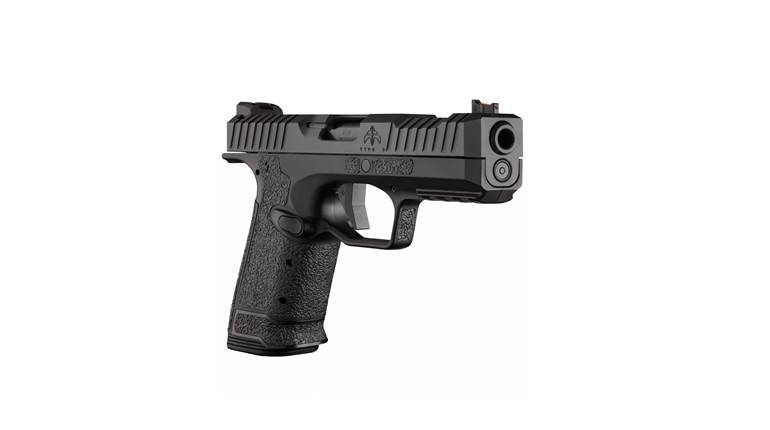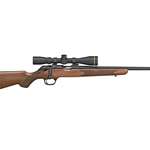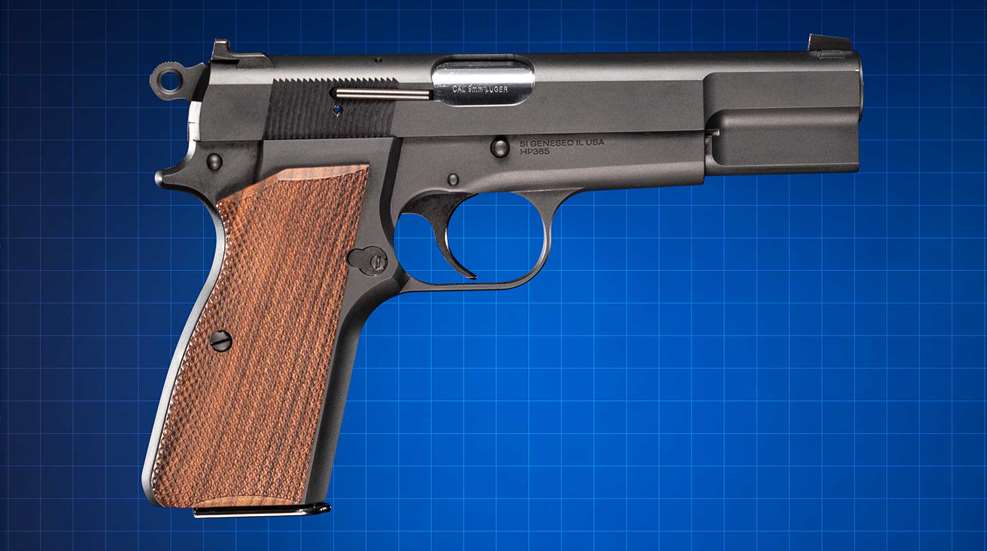
Iconic firearm designs, no matter how universally recognized, eventually leave the market. When sales slow or production costs rise to a prohibitive point, they become a part of history rather than inventory. Early semi-automatics, such as the P08 Luger or Walther P38, long ago left the market, but their service-pistol contemporary, the P-35, or Browning Hi Power, endured until 2018. When Fabrique Nationale and Browning finally stopped offering the pistol under that trademark, many shooters were disappointed and hopeful that a major manufacturer would carry the design forward. In a surprising move, Springfield Armory has done just that.
Springfield looked at the market and, noting demand for the classic John Browning design, decided it would be a natural fit within its product lineup. The result is the SA-35, which hearkens back to the P-35 pistol that became one of the most prolific military sidearms from World War II through the Cold War era. Despite a host of specific designations, and appellations such as Grande Puissance, the design today simply goes by High Power.
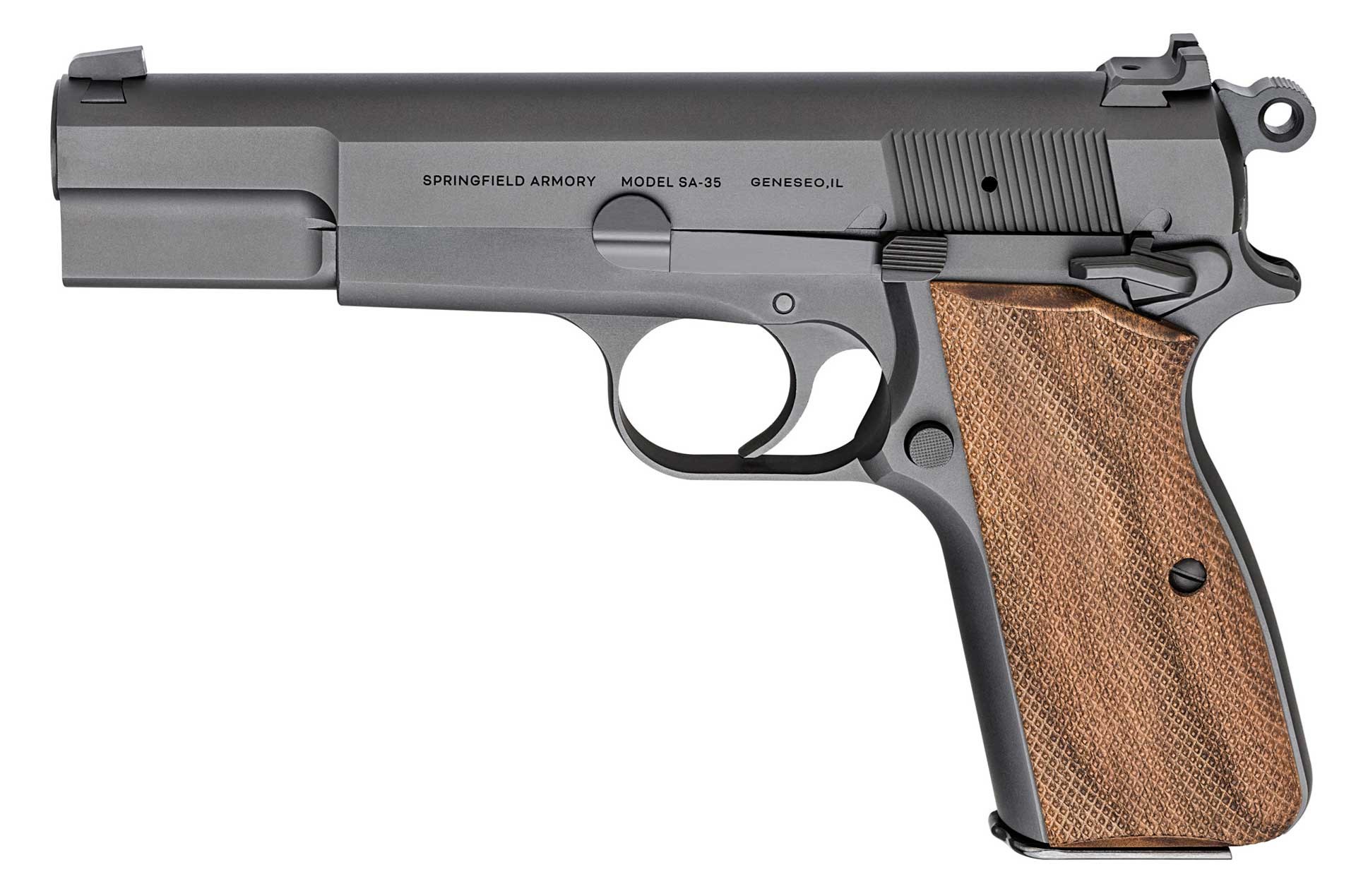 According to Springfield CEO Dennis Reese, “The SA-35 represents a classic firearm design born from the genius of John Moses Browning. Just like the 1911 before it, this pistol was truly revolutionary and would influence firearm design for the decades that would follow, even through to today. Springfield Armory recognized there would be strong demand for an offering like this in the market and that a firearm like this would be a terrific fit for the Springfield Armory firearms family.”
According to Springfield CEO Dennis Reese, “The SA-35 represents a classic firearm design born from the genius of John Moses Browning. Just like the 1911 before it, this pistol was truly revolutionary and would influence firearm design for the decades that would follow, even through to today. Springfield Armory recognized there would be strong demand for an offering like this in the market and that a firearm like this would be a terrific fit for the Springfield Armory firearms family.”
The SA-35 is a faithful rendition of the classic, with those timeless and attractive lines immediately recognizable but with shooter-friendly enhancements tastefully included throughout. In the fashion of its M1911 progenitor, it is a locked-breech, single-action, semi-automatic design in which the hammer is cocked via racking the slide and the manual thumb safety engaged to ready it for immediate use. Such a cocked-and-locked condition allows a consistent, relatively light and crisp trigger break for each shot.
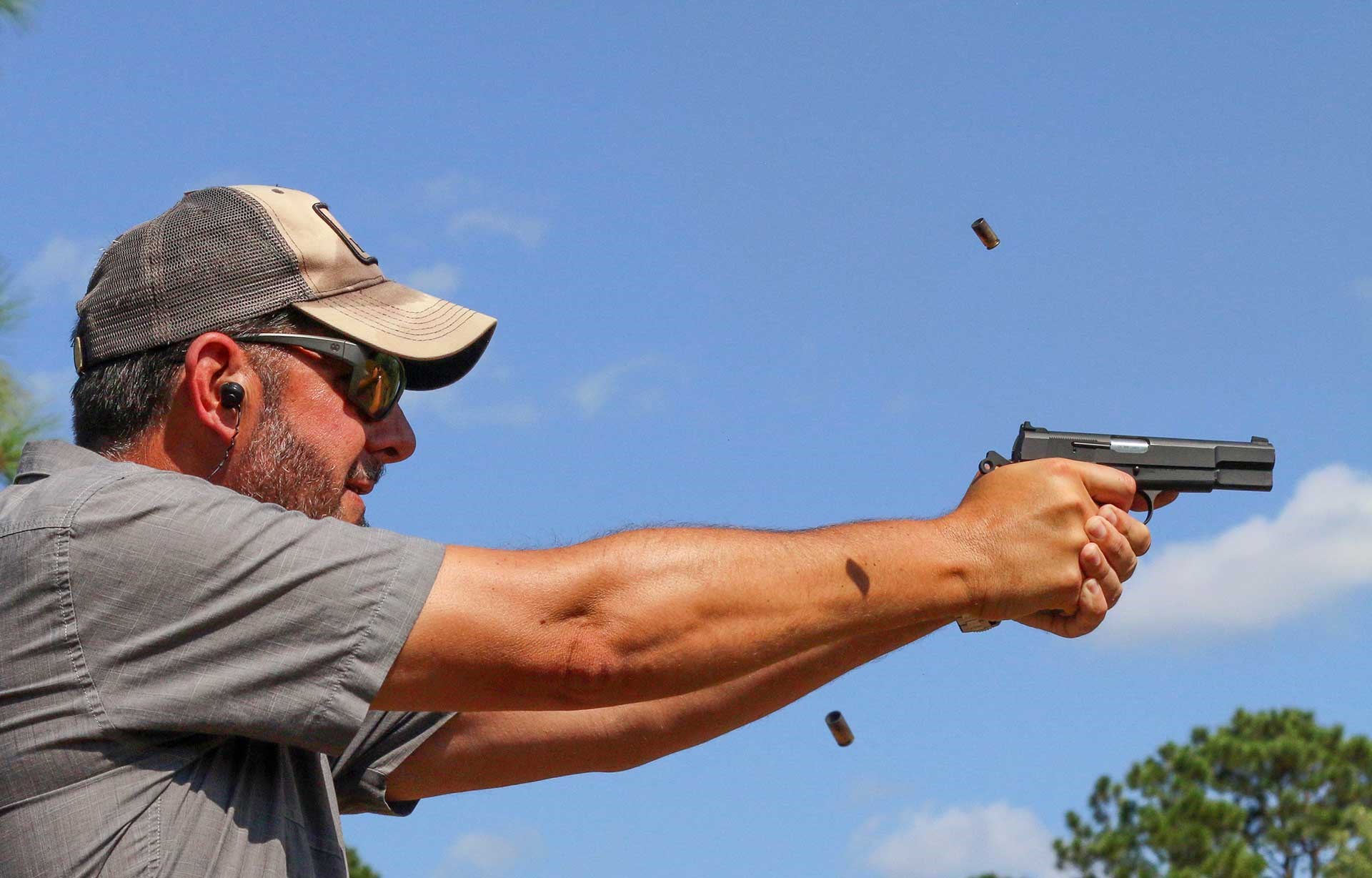 The Springfield pistol employs a forged-steel frame and slide and nicely shaped checkered walnut stocks. The original High Power design featured a 13-shot magazine, but the SA-35 ships with a magazine that features an improved follower design allowing for a 15-round capacity. Many iterations of the High Power design had caveats suggesting limited or no use of +P 9 mm Luger loads, but the forged SA-35 is fully +P-rated.
The Springfield pistol employs a forged-steel frame and slide and nicely shaped checkered walnut stocks. The original High Power design featured a 13-shot magazine, but the SA-35 ships with a magazine that features an improved follower design allowing for a 15-round capacity. Many iterations of the High Power design had caveats suggesting limited or no use of +P 9 mm Luger loads, but the forged SA-35 is fully +P-rated.
The High Power is a design for which most shooters have strong affection, but those same users can also harbor a substantial list of gripes. If you look at the common customization packages from pistolsmiths known for High Power work, you will see the list of things shooters frequently complain about regarding the stock pistol. Custom High Powers tend to feature enhanced sights, eliminate the magazine-disconnect safety, replace or re-contour the hammer to eliminate hammer bite, change the shape of the thumb safety, improve the trigger pull, replace the stocks and bevel the magazine well.
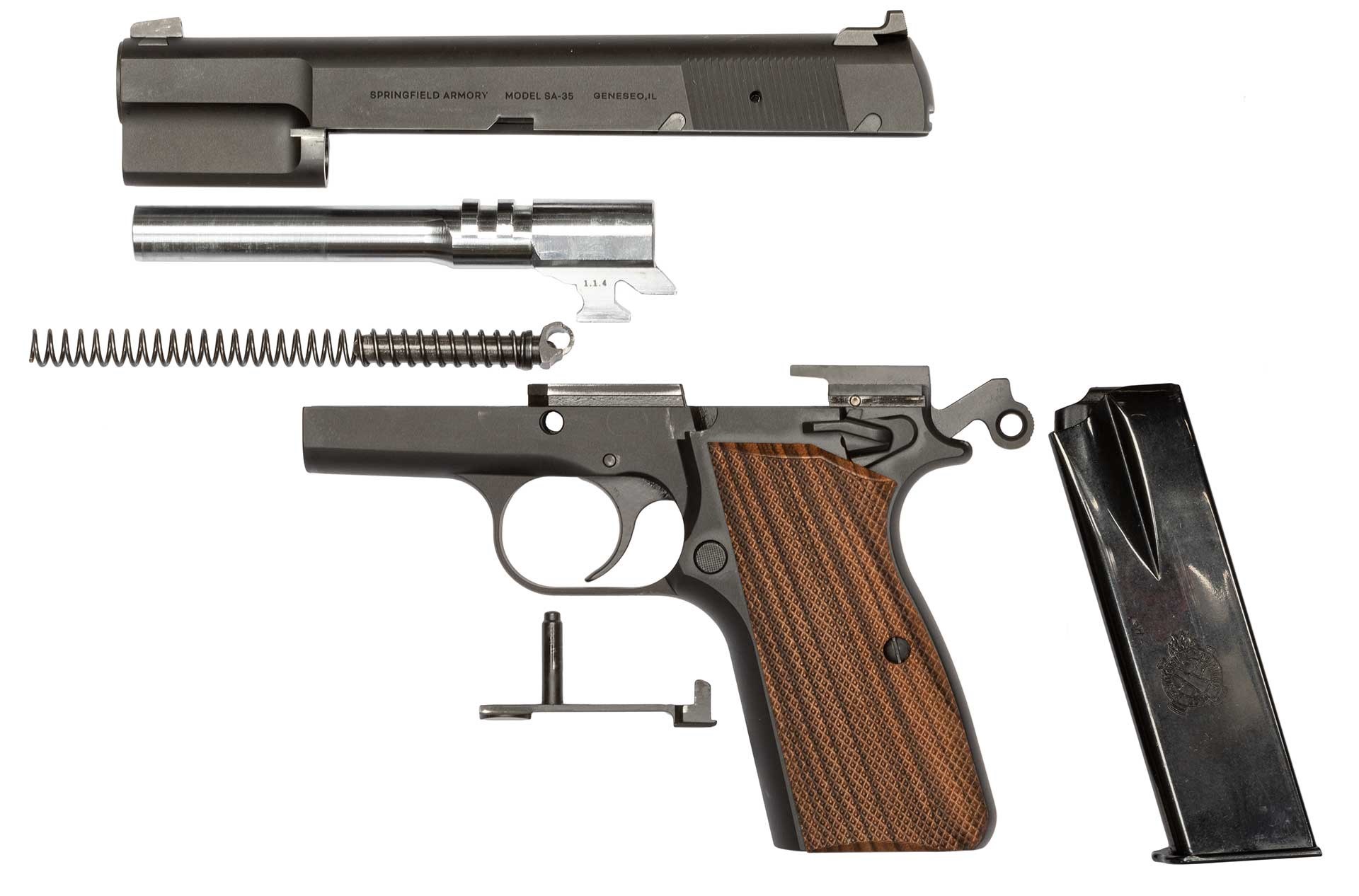
The SA-35’s design remains fundamentally unchanged from that of previous High Power examples, with fieldstripping revealing familiar components and features that were co-developed by John Moses Browning and FN’s Dieudonné Saive.
Springfield seems to have studied this list of common custom upgrades and used it as a reference in designing its rendition. From my perspective, the SA-35 easily has the best sights, thumb safety, trigger pull, stocks and magazine well of any factory offering in the design’s 85-plus-year history. Before making such a bold claim purely from memory of pistols seen or handled, I borrowed samples of Brownings ranging from 1990s Mk IIIs to Mk IIs and earlier post-war production examples, as well as some full-house custom pistols. I can state that, from a shooter’s perspective, this is the production High Power that sets a new standard for being ready to go straight out of the box.
The sights are unique; a white-dot front exceptionally well blended into a dovetail paired with a wide U-notch serrated rear blade make for an easily acquired sight picture. The rear blade has an elegant shape that seems to combine elements from several popular aftermarket and bespoke rear sights. I rather liked the sight picture afforded by them and found the wide notch to help recover the sights quickly when shooting at the edges of my abilities. High Power sights are relatively sparse on the aftermarket and often require proprietary milling cuts, so having an attractive and effective set out of the box is much more important than with most contemporary pistols.
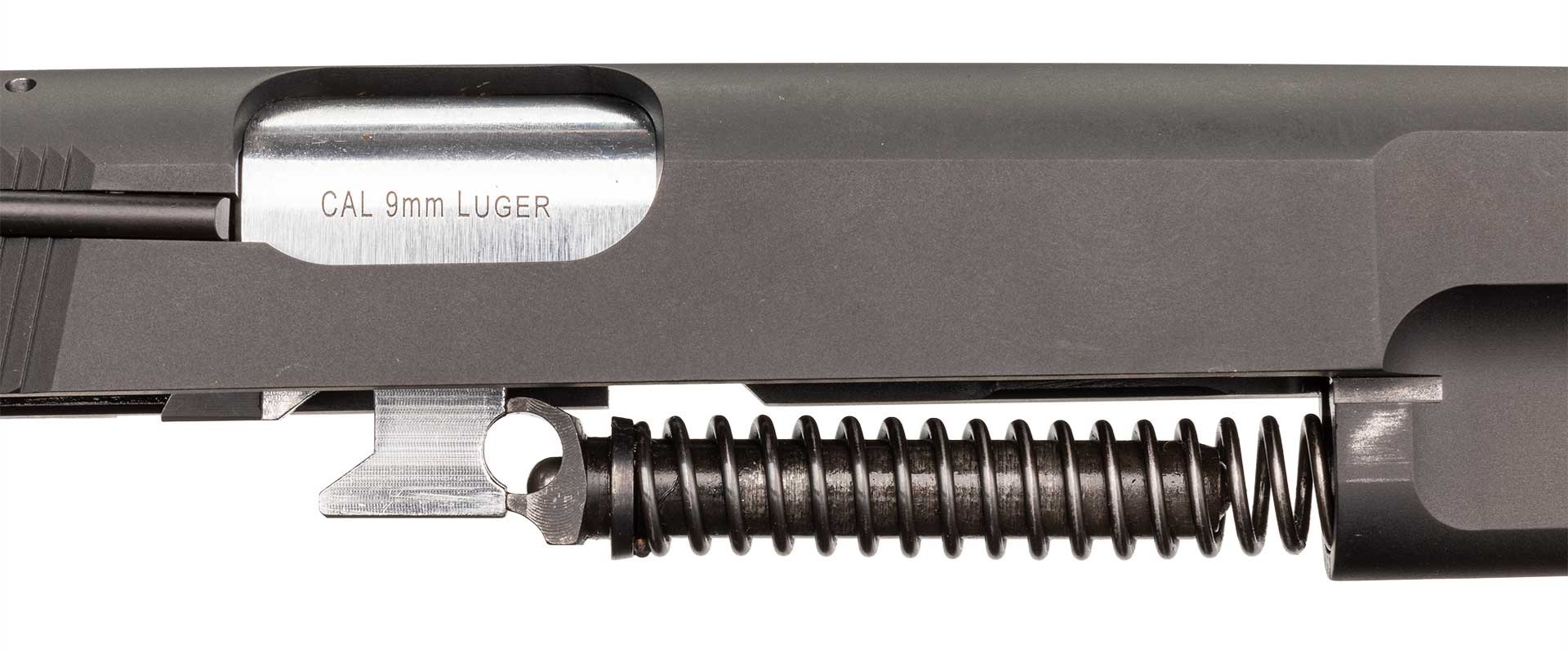 The magazine-disconnect safety was a requirement stipulated by the French army in its pistol trials, forcing John Browning and FN’s Dieudonné Saive to include it in the submission, which ultimately became the P-35. Although the French went with another pistol, the Belgians quickly adopted the design, and it was issued by both Axis and Allied troops during World War II. The disconnect prevents the pistol from firing unless a magazine is inserted. Most designs since have ignored the feature, and many High Power owners have had it removed to improve their pistols’ trigger pulls. Springfield wisely went without a magazine disconnect on the SA-35. Also, like Springfield’s M1911 offerings, the new SA-35 features a traditional firing pin arrangement devoid of so-call Series 80 firing-pin safety components.
The magazine-disconnect safety was a requirement stipulated by the French army in its pistol trials, forcing John Browning and FN’s Dieudonné Saive to include it in the submission, which ultimately became the P-35. Although the French went with another pistol, the Belgians quickly adopted the design, and it was issued by both Axis and Allied troops during World War II. The disconnect prevents the pistol from firing unless a magazine is inserted. Most designs since have ignored the feature, and many High Power owners have had it removed to improve their pistols’ trigger pulls. Springfield wisely went without a magazine disconnect on the SA-35. Also, like Springfield’s M1911 offerings, the new SA-35 features a traditional firing pin arrangement devoid of so-call Series 80 firing-pin safety components.
The original P-35 and pretty much all subsequent High Powers have been saddled with a succession of dinky or awkwardly shaped thumb safeties. I’ve tried most of the aftermarket safeties available on customized pistols, and I found the SA-35 design to be my favorite so far. It is trim yet well-shaped and “snicks” on and off positively with about the ideal amount of resistance. SA-35 shooters will fall into two camps—those who ride the safety with their thumb high and those who curl their thumb underneath the safety as they grasp the pistol. Both camps will find the Springfield component to their liking.
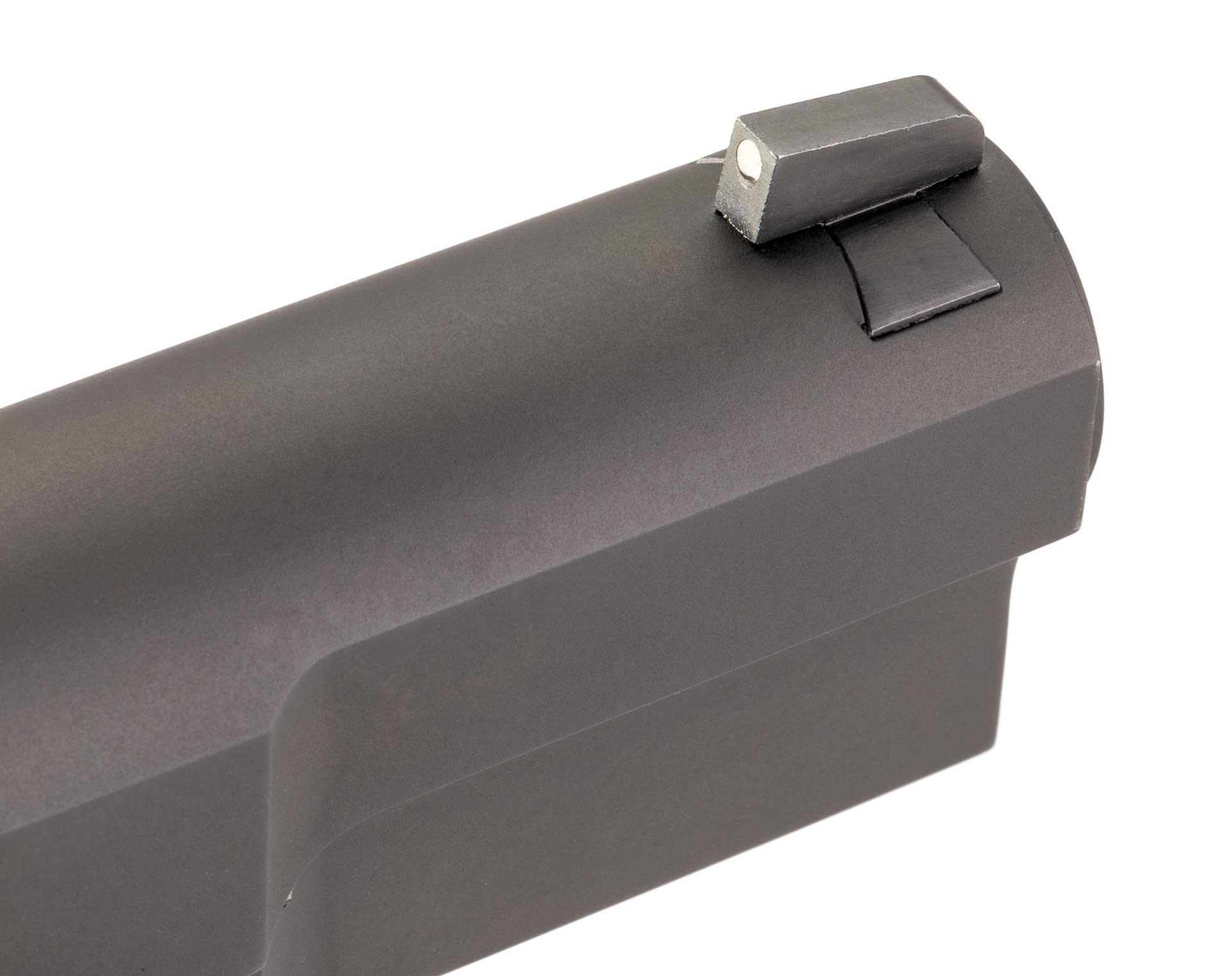
Both front and rear sights on the Springfield SA-35 are dovetailed into the slide. The front is a post with a white dot.
The SA-35 uses a rowel hammer that looks right at home on the pistol. The hammers on High Powers often “bite” shooters, pinching the fleshy web of the hand between the tang and hammer as the slide reciprocates. This is why you see high-end custom High Powers with welded-on beavertails or shortened and reshaped hammer spurs. The SA-35 hammer is well-shaped, creating a gap to reduce hammer bite while keeping the traditional tang and vintage appearance of the rowel. I have extra-large hands, and I grasp pistols as high as is possible, leading to hammer bite with many older designs. With the Springfield, I was able to fire more than 200 rounds in a session before the skin broke and my hand became somewhat uncomfortable.
The trigger on the SA-35 broke at 4 lbs., 13 ozs., with a light take-up transitioning to a crisp wall that broke cleanly with just a hint of movement. If I could clone this exact trigger onto my personal Browning Hi Power, I would—in an instant. That pistol is a Mk III with the disconnect removed and some moderate trigger work done, and it still breaks at 6 lbs., 12 ozs. A stock Mk III .40-cal. I measured had a trigger at 7 lbs., 3 ozs. with a gritty takeup. I weighed two custom Brownings, both with aftermarket triggers, sears and hammers installed. The first was quite good at 5 lbs., 3 ozs., with a break not quite as nice as the SA-35 and the other was remarkable at a scant 3 lbs.—but probably too light for many shooters. If all SA-35 triggers are as good as the one on my test sample, it will be a real achievement on Springfield’s part.
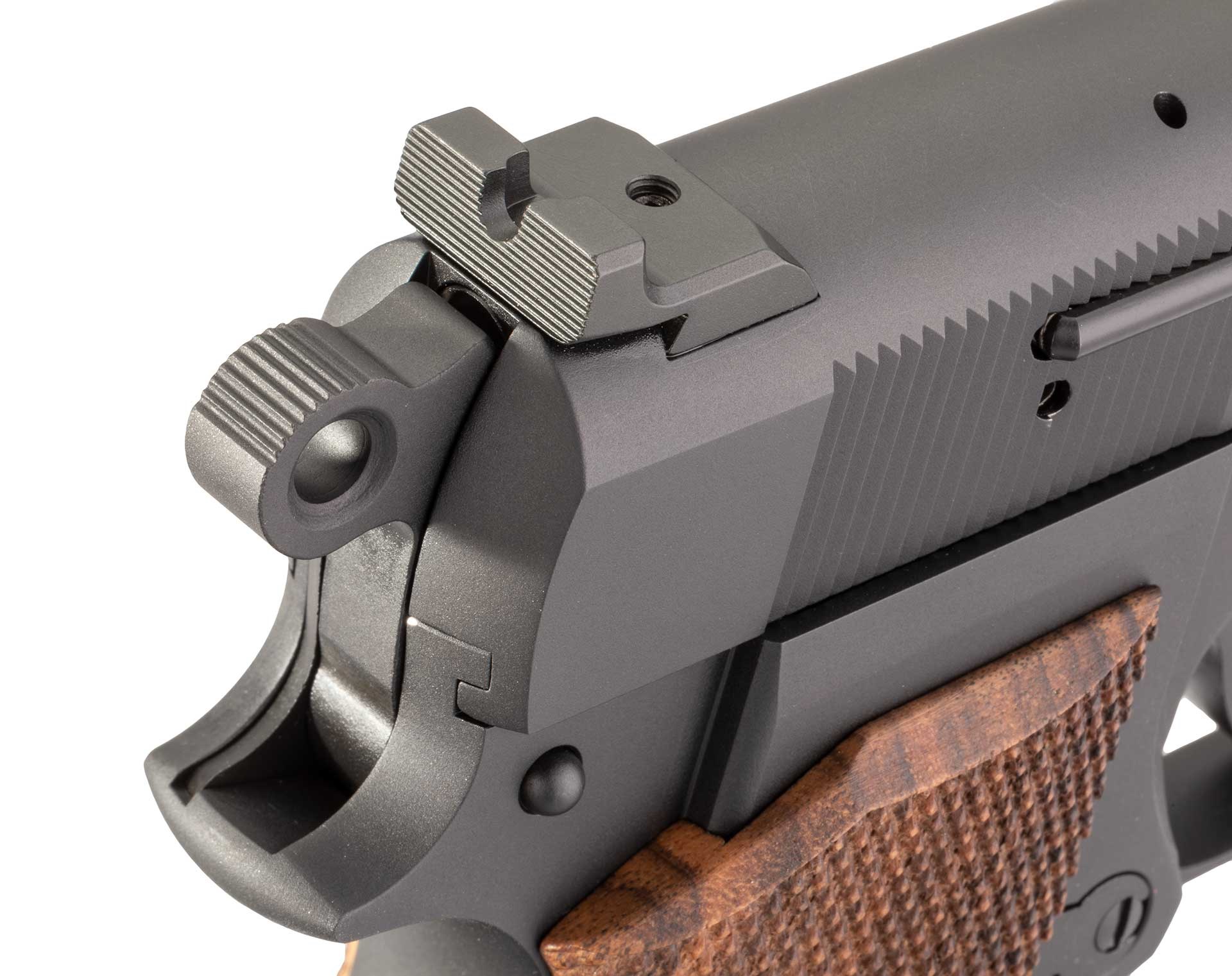
The rear sight features a U-notch cut and serrations along with a profile that permits it to aid in racking the slide on a hard surface.
When the P-35 was designed, there was little emphasis on speed reloads, so the magazine well was designed without a flared entrance. The High Power magazine was one of the first double-column pistol box magazines and a real technical achievement, but later designs would incorporate much more taper at the top. The original remains fairly boxy at the top with prominent square edges at the front, beneath the exposed cartridges. The result is that a High Power benefits from a beveled magazine well more so than most pistols. Springfield has provided as much bevel to all four sides of the SA-35 magazine well as the frame can accommodate.
One other issue that High Power owners have contended with is that the serial numbers have traditionally been engraved into the middle of the forward portion of the grip frame. This challenges aftermarket checkering or texturing of the frame, requiring the pistolsmith to work around the serial number. Springfield thoughtfully moved the serial number to above the trigger guard on the right side of the pistol.
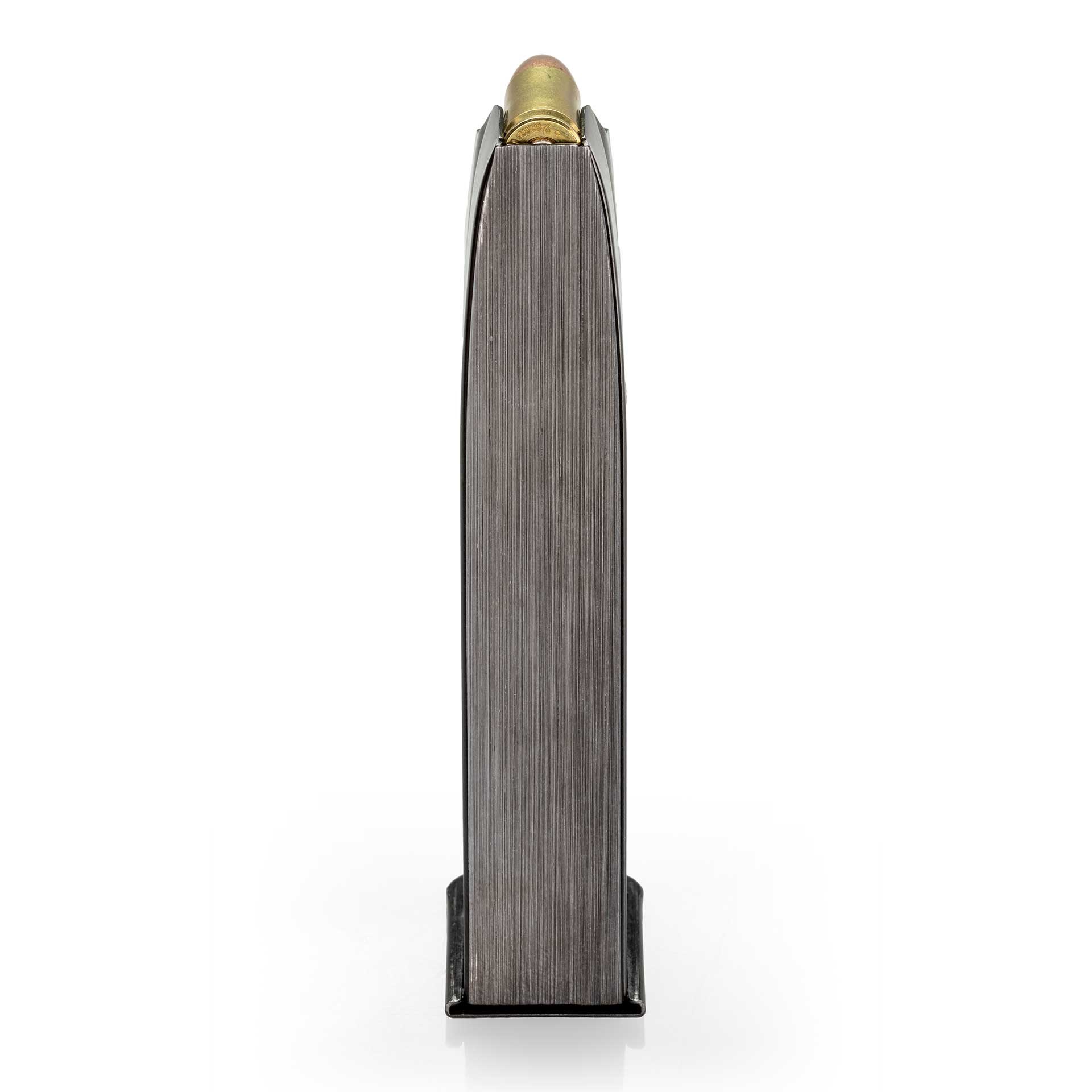
The SA-35 comes with a 15-round magazine manufactured by Mec-Gar in Italy, which represents an upgrade to the original High Power’s nearly 87-year-old 13-round magazine design.
Shooting the SA-35 was an enjoyable experience across several range sessions. In a market full of ever-shrinking micro 9s, I was reminded just how pleasant a steel-frame, hammer-fired 9 mm Luger-chambered pistol can be to shoot. The 38-oz. loaded weight steadies the pistol while recoil is partially bled off as the slide cycles, the energy cocking the hammer and compressing the hammer spring. The legendarily comfortable grip shape then combines with the Springfield’s excellent sights and trigger to allow very good hits to come with minimal effort on the shooter’s part. I found the pistol to point well as I extended onto the target and returned well under recoil.
Mechanically, the SA-35 shot up to my high hopes. The pistol grouped right to the sights, and most loads clustered tightly. All three loads tested averaged comfortably under 2", with a couple of bragging-rights-level clusters along the way. I came into some Remington small pistol primers (the first primers I’ve been able to source in more than 18 months) and assembled a favored match load, featuring a 147-grain Zero jacketed hollow point, and the SA-35 poked four of those into a beautiful 0.5" hole, with the fifth stretching the group to a tenth under 1.5".
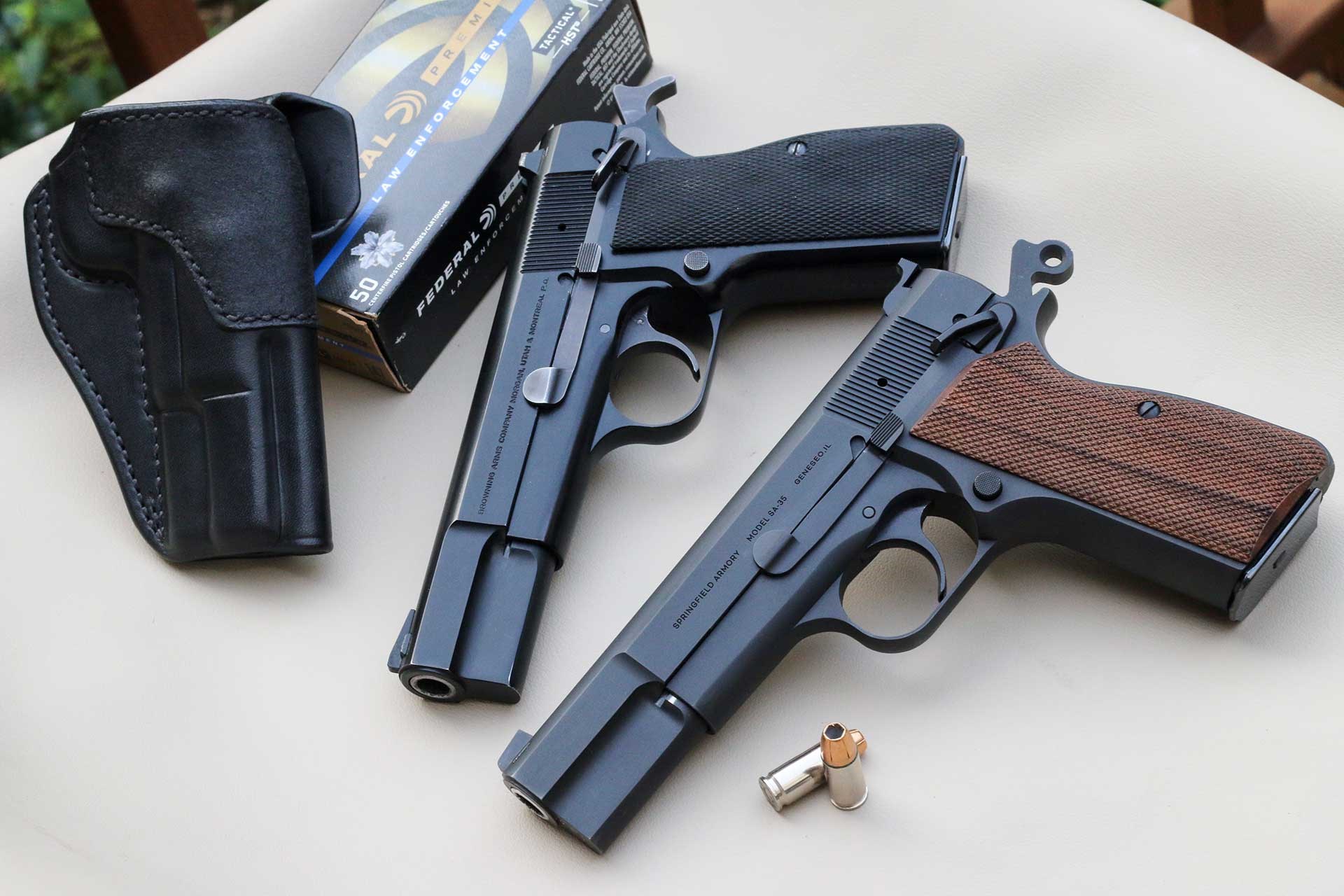
The author’s old Browning Mk III Hi Power ran perfectly using the new SA-35’s barrel and slide assembly, which proves that the newer gun remains true to original specifications. Note also the high-quality 5 Shot leather holster, which fits either gun equally well.
The Springfield shone in all of my standard drills and exercises. On my first run at the 10-yard plate rack, I was knocking all six of the 8" plates faster than I can with most stock service pistols. Within a few runs, the SA-35 was racing across the plates in that rarified time frame I can only reach with a small number of favored pistols.
On challenging drills, like the 10 Second Showdown, a timed exercise that incorporates a draw, a reload and multiple shots at 13, 10 and 7 yards, as well as shots on the move (see more details on the drill here) the SA-35 was again shooting more like a high-performance pistol than a stock gun. The ease of shooting gave me a good idea of why special units, such as the British Special Air Service and the FBI’s Hostage Rescue Team, had famously chosen customized variants of the High Power for a period of time.
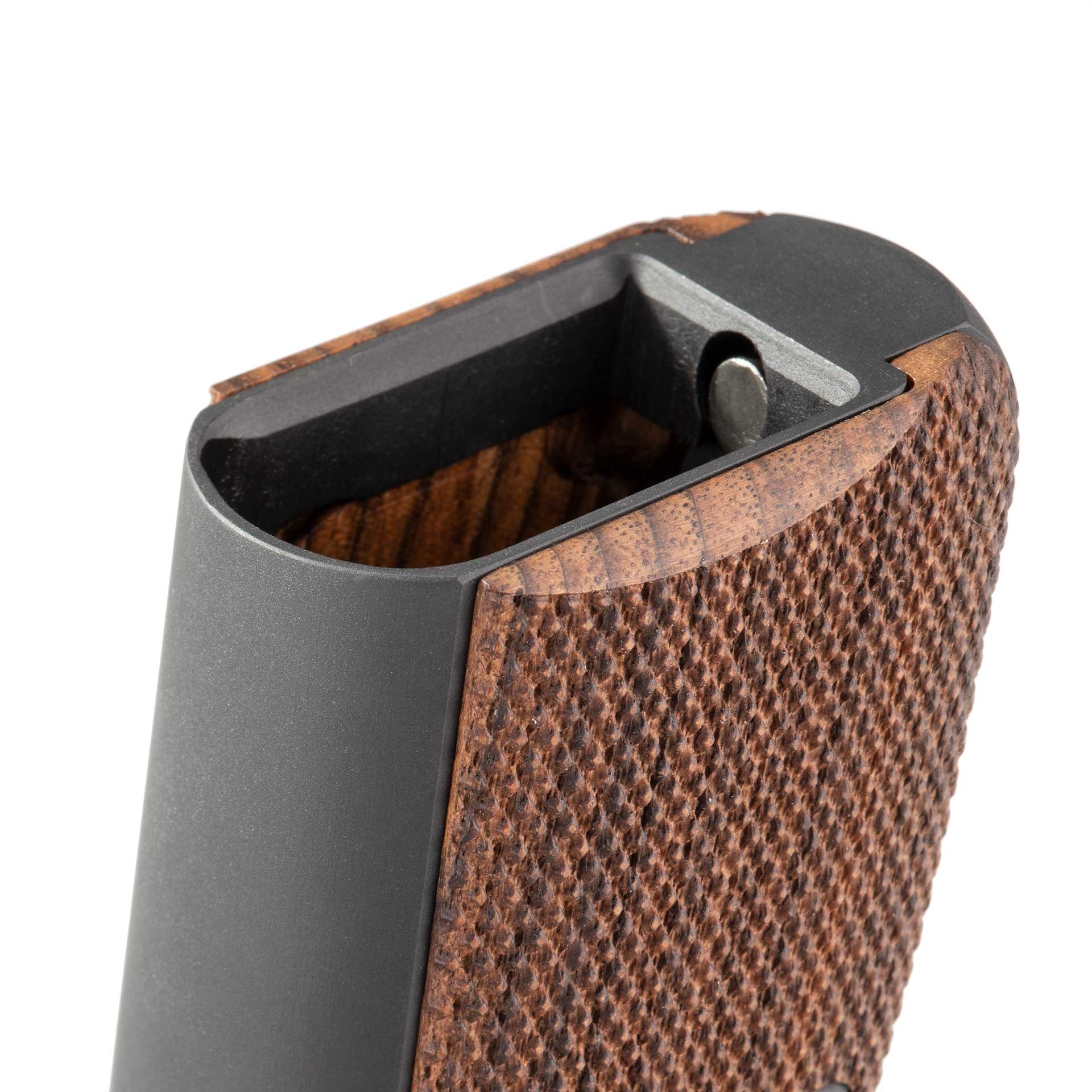
Another small, but important, enhancement offered by Springfield on the SA-35 is beveling on all four sides of the magazine-well opening.
Since the Springfield had the accuracy “under the hood” and such an agreeable trigger and sights, I pushed it on less practical but very demanding tasks just to test its capability. One of my recent favorites in this category is to begin aimed and ready to fire on an 8" steel plate at 25 yards. On the buzzer of my shot timer, I shoot the first plate and then recover the handgun as quickly as possible onto the second plate and hit it. This gives me a good sense of just how well the sights, trigger and the pistol’s recovery in recoil are working for me. Within a few attempts, I was confidently pushing the SA-35 at speed, and it was recording times that caused me to do a double-take.
I repeated the same basic two-plate drill at 40 yards with the Springfield. For me, 40-yard plates are a staple—I love the challenge, and many pistols will ring the steel more often than not, if I do my part. Tackling 40-yard plates at aggressive speed, however, requires an excellent tool that “gels” with the shooter. The SA-35 was regularly hitting the second plate while the “Ting!” from the first hit was still vibrating in the air.
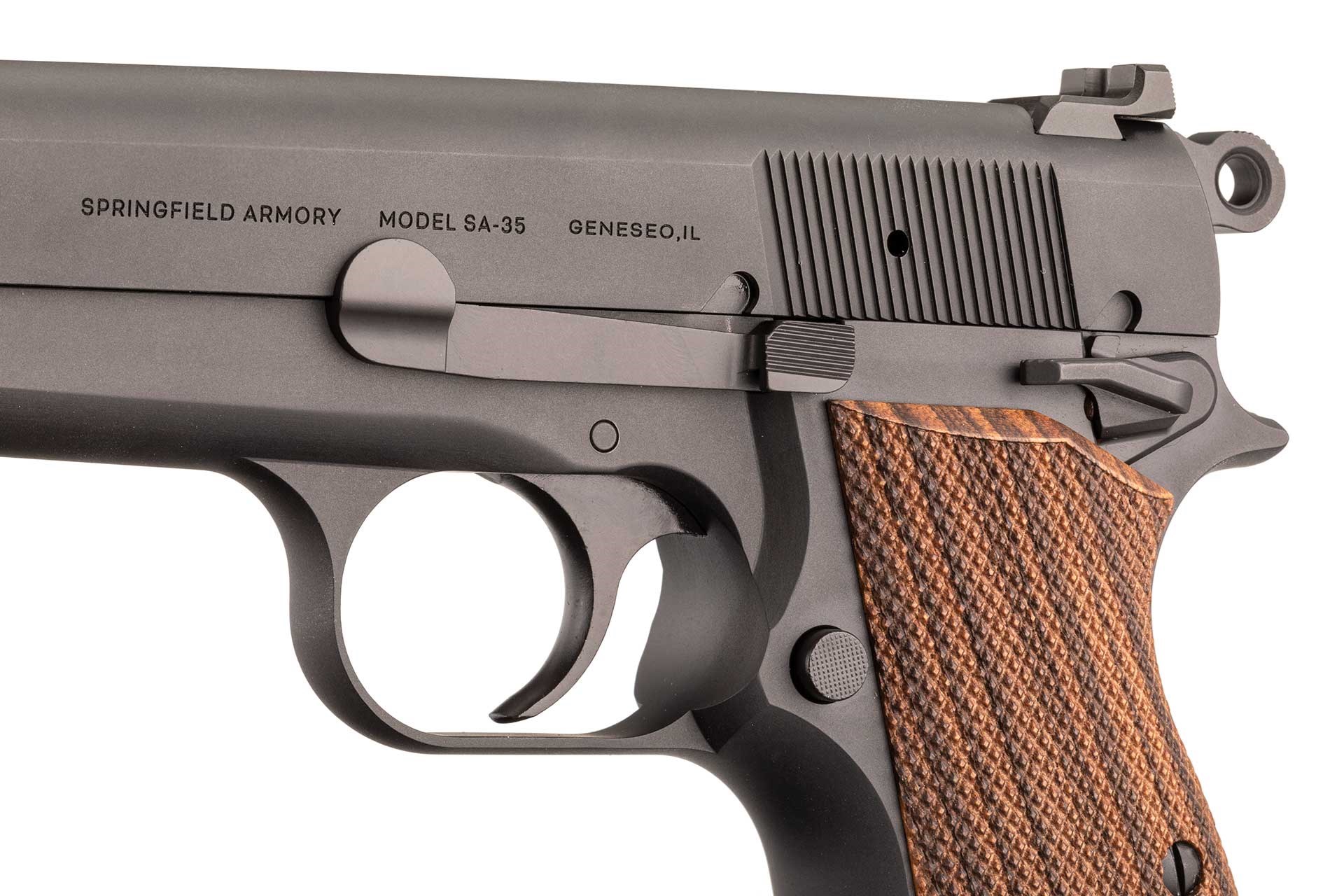
Controls on the SA-35 consist of the traditional, High Power-style slide stop and magazine release, along with an enhanced safety that features an elongated and contoured lever.
I fired more than 780 rounds through the SA-35. Shooting that many rounds during an historic ammunition shortage speaks pretty clearly as to how much I was enjoying the pistol; a tight timeline was all that kept the number from being higher. Of those 780 rounds, I had one stoppage when a round failed to extract. It was loose in the chamber, and there was a mark on the rim where the extractor scored it, so it is possible that the rim was undersized or that there was one hiccup with the extractor. In all, the SA-35 cycled 13 different types of loads, seven of those hollow points, without issue. I fired +P loads from Black Hills and Super Vel, and the steel pistol shot them rather softly compared to many popular designs.
Springfield used the original design specifications for the SA-35, so shooters can expect some degree of interchangeability of parts. I was able to take the slide and barrel off the SA-35 and slip them right onto my old Browning frame and immediately start knocking over steel plates. Older Browning stocks and magazines were interchangeable with no issue.
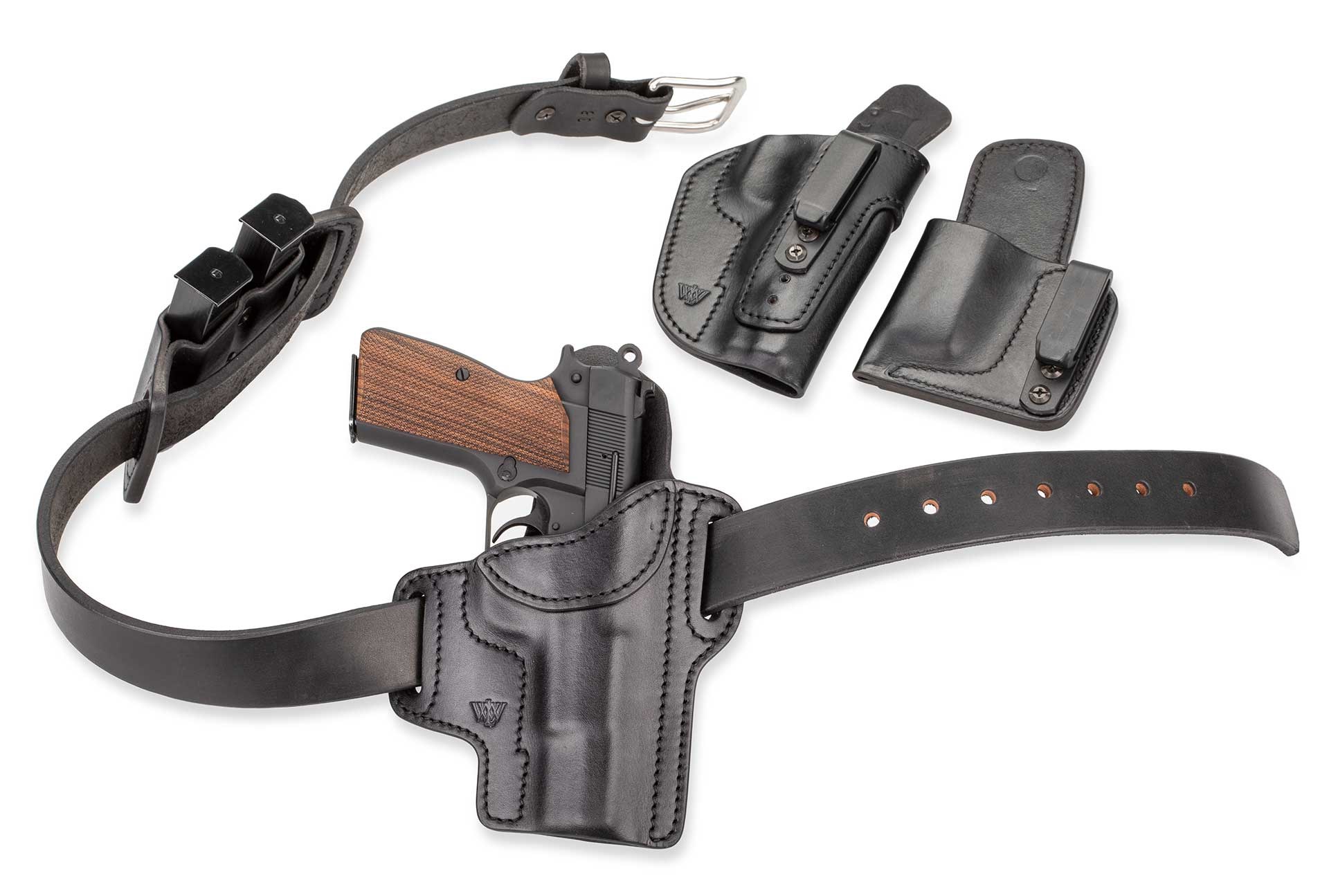
Thanks to its narrow slide, the SA-35 rides comfortably in a Wright Leather Works’ Predator Pancake holster, shown here with the Double Mag Pancake carrier on the Old World Gun Belt, or inside the waistband in the Cruiser Clip Holster with Mag Holster (above, r.).
The only negative I have at this point is that the SA-35 has a fairly abrupt edge at the rear corner of the tang, which was a hotspot for me. For many shooters, this will go unnoticed, but with my grasp, I would need to break that edge with a stone. Another item that is more of a wish than a criticism would be for Springfield to offer an extended baseplate for the magazine, whether a simple bumper or an additional-capacity extension.
The SA-35 has a compact grip compared to many pistol designs, and the magazine extension would aid reloading considerably. Pachmayr used to offer glue-on rubber pads, and I swapped a couple of baseplates with those bumpers installed onto the Springfield 15-round magazine bodies. I also ordered some leather bumpers from Andy’s Leather for evaluation.
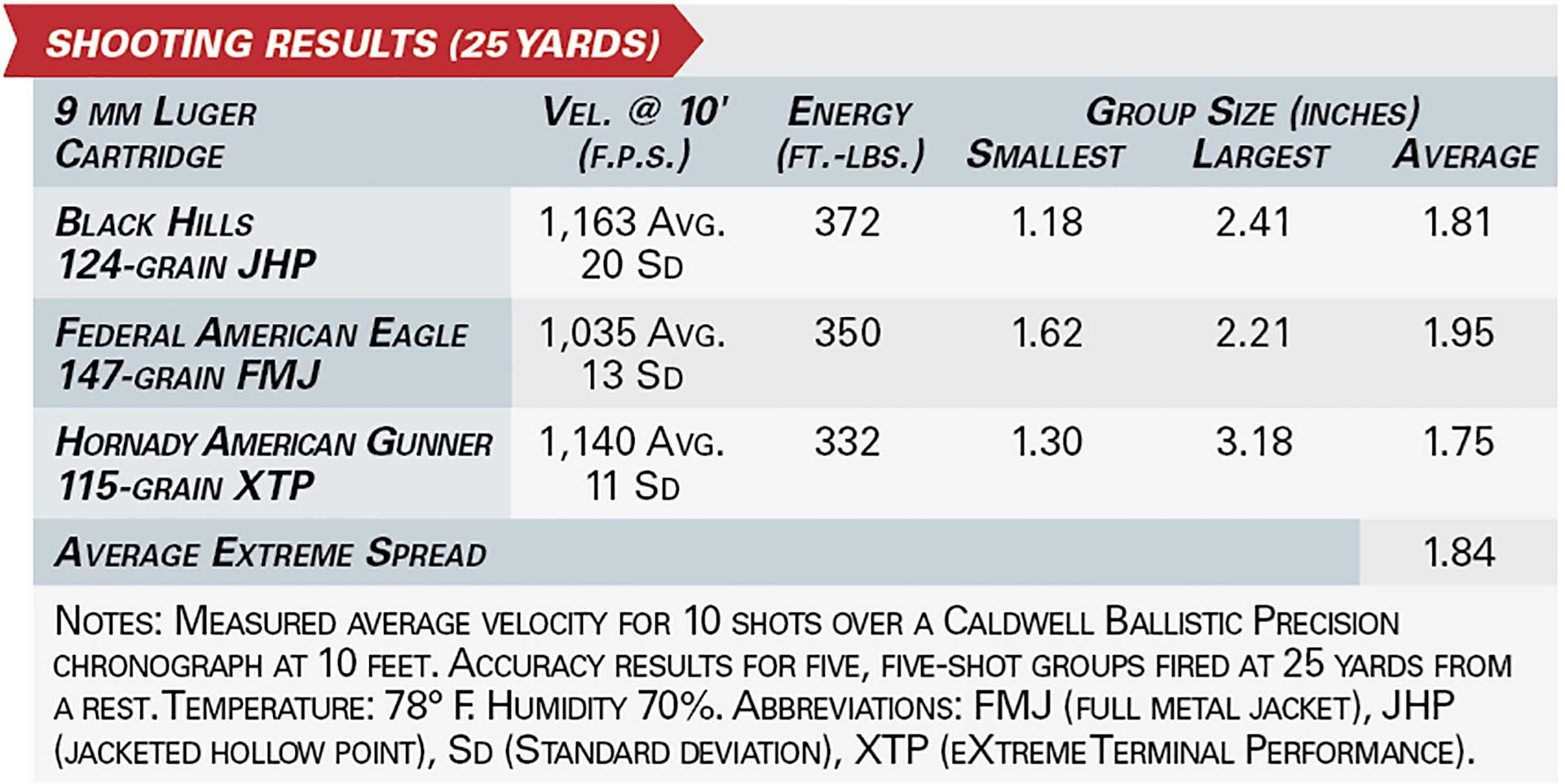
The SA-35 is a full-size pistol, but it is trim and svelte in ways that might surprise shooters whose frame of reference is the boxy striker-fired genre. The SA-35 is similar in overall height to a Glock G19 and in length to a Glock G17. However, the SA-35 is barely 7/8" across at the slide—or as thin as many of the popular micro slimlines. This allows the SA-35 to carry very well and seem like a much smaller gun.
With the Hi Power out of production, holsters are not as common as they once were, but DeSantis, Galco, Safariland and Wright Leather Works either have or soon will have models. For many shooters, a classic pistol like the SA-35 just cries out for a beautiful, handmade, custom holster, so I reached out to 5 Shot Leather in Washington state, which responded with an absolutely stunning black Old School Speed Scabbard. The custom holster was precisely hand-boned to a Browning Hi Power, and the SA-35 fit it perfectly, the lines of the classic designs melding into a gorgeous pair that carried nicely on the belt.
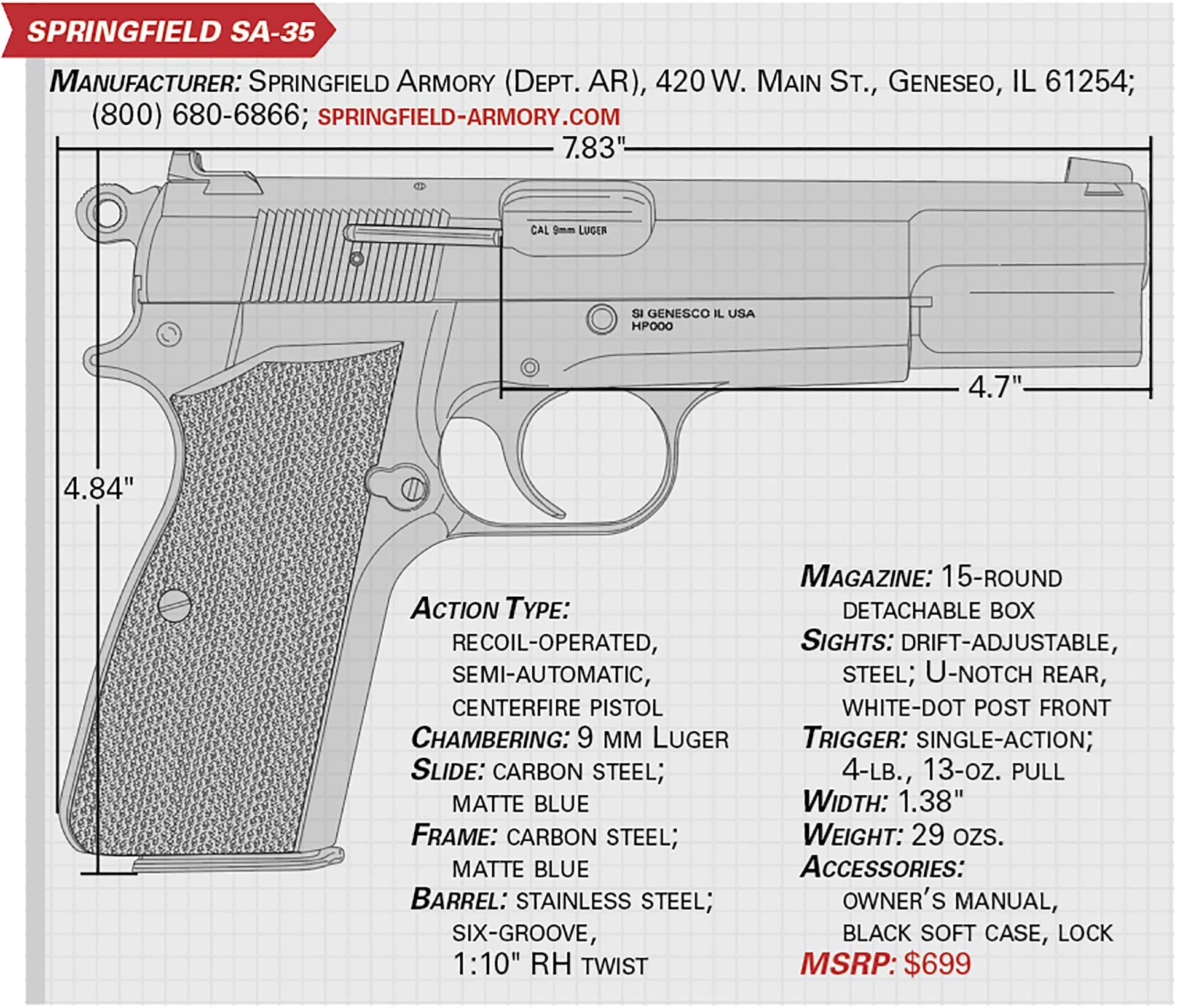
I own a Browning Mk III Hi Power that I have had now for 20 years that was a gift from my wife to mark the occasion of my first Father’s Day. Almost immediately, I swapped out the stocks and changed the thumb safety. I had a Marine Corps Match Armorer remove the magazine disconnect and install a lighter hammer spring to lighten the trigger. Swapping some beer and spare parts for his time, I then had him bevel the magazine well. The pistol is special to me but has always needed more work to shoot up to its potential.
Every couple of years, I have considered installing better sights, replacing the sear and hammer to get a truly good trigger break or bobbing the hammer spur. However, the effort and expense of those things has always caused me to put it back in the safe and move on to other projects. Handling the SA-35, I was struck by how much the sum of its features were exactly what I wished for on my old Browning.
Springfield Armory seems to be enjoying a mini “golden age” of sorts. From the quality of the Ronin 1911 pistols I reviewed last year, to the popularity of the Saint series of ARs and micro-compact Hellcats, and the unexpected introduction of the innovative Waypoint bolt-action rifle, the company is making bold moves. Its decision to rescue the High Power is great news for shooters. I am particularly excited that many shooters trying out the SA-35 may experience not only their first High Power but arguably the most refined one ever offered.













